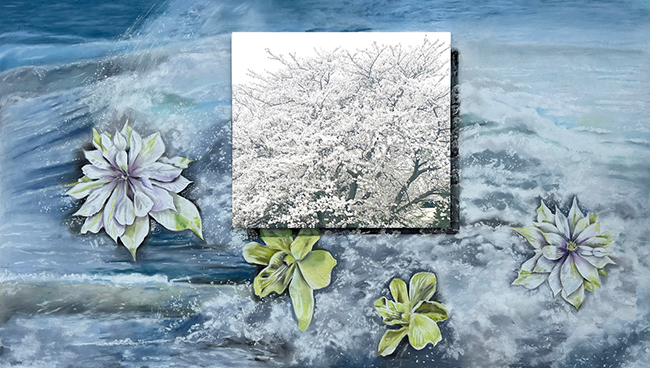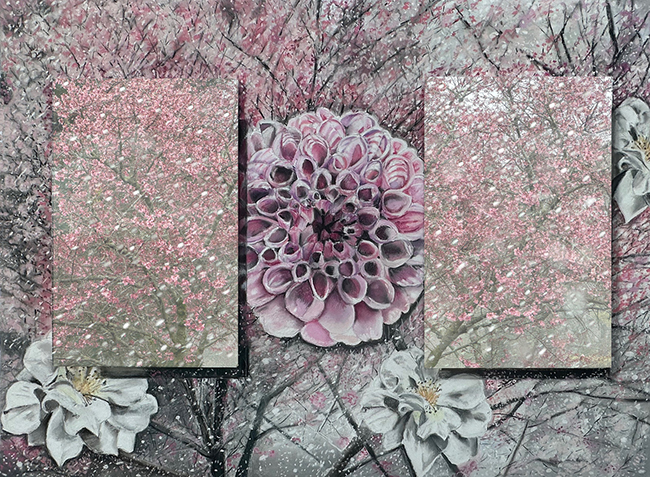Nancy Staub Laughlin isn’t trying to fit into a box. She works in pastel and photography, and instead of choosing one over the other, she brings them together in ways that feel both grounded and dreamlike. She earned her BFA from Moore College of Art in Philadelphia, and over the years, her work has been shown in galleries and museums along the East Coast. Her pieces are also part of corporate and private collections, and she’s been interviewed and written about in various publications. The late Sam Hunter, a respected art critic and historian, once called her work “refreshingly unique”—and that phrase still fits.
Laughlin’s art is full of detail and intention, but not in a rigid way. What she makes feels like a careful invitation. She sets the stage, but there’s room for you to wander. She’s not just showing you what’s there—she’s asking you to slow down and look.
Let’s talk about a few of her works.

“The Anticipation of Spring Allure” is 22 by 58 inches. It’s pastel on paper combined with a photograph. The photo, she says, is of a dahlia from her own garden. She sprayed it with water in sunlight to create a kind of frozen sparkle—a moment of natural magic caught just right. Then she pairs that photo with a pastel composition that includes a wintery landscape and soft peach zinnias. It’s a season in tension. Winter hasn’t let go yet, but spring is pushing through, and in that overlap, she finds beauty. The image doesn’t declare one thing—it lingers in the space between.
That’s something Laughlin does often. Her art doesn’t always rush to resolution. She’s more interested in how things shift—how light touches form, how nature crosses into abstraction, how photography and pastel overlap in a way that feels quiet but alive.

“The Blossoming of Froth” is larger—31 by 55 inches—and again combines pastel and photography. This time, she’s looking at the edge where land meets sea. Sea spray turns into blossoms. Ocean foam and spring flowers become part of the same dream. This isn’t about literal representation. It’s about feeling your way into a world where everything is lush, a little surreal, and carefully composed.
There’s a kind of softness in her palette—a leaning into pastels not just as a medium but as a mood. The work feels fresh without being loud. It invites closeness. You can imagine standing right there, watching sea foam curl into petals, watching sunlight stretch across the water. Laughlin isn’t separating nature from imagination—she’s showing us that they live in the same place.

Then there’s “The Transition to Spring,” a 24 x 33 inch piece, again blending pastel with photography. Here, she says she aims to immerse the viewer in her world of “color, light, dimension, and beauty.” And that really does get to the heart of what she’s doing. The work is carefully arranged—crafted through a long process that balances control with intuition. You can feel that nothing in these pieces is random, even though the images themselves feel light, almost like they’re floating.
Her process matters. She doesn’t just snap a photo and sketch around it. She starts with a vision, builds the photo, then surrounds it with pastel until it all clicks together. It’s not a collage. It’s not traditional realism either. It’s something in between—its own space. She calls it “my radiant and captivating world.” That may sound bold, but when you look at the work, it makes sense. She’s not painting what she sees. She’s creating a version of reality that reflects how she experiences beauty.
And that’s where her work really lands. It’s personal, but not private. It opens a door and lets you in. Whether it’s garden flowers sprayed with sunlight or sea foam imagined as blossoms, she’s crafting something generous—an offering of stillness, wonder, and layered detail.
Nancy Staub Laughlin doesn’t follow a trend or chase after big statements. She stays close to her process, close to the quiet transformation of nature, and close to the gentle pull of color and light. And in doing so, she gives us work that’s not just “refreshingly unique”—it’s quietly necessary.

